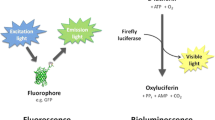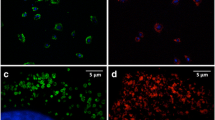Abstract
Purpose
Cell-based therapy by transplantation of progenitor cells has emerged as a promising development for organ repair, but non-invasive imaging approaches are required to monitor the fate of transplanted cells. Radioactive labelling with 111In-oxine has been used in preclinical trials. This study aimed to validate 111In-oxine labelling and subsequent in vivo and ex vivo detection of haematopoietic progenitor cells.
Methods
Murine haematopoietic progenitor cells (106, FDCPmix) were labelled with 0.1 MBq (low dose) or 1.0 MBq (high dose) 111In-oxine and compared with unlabelled controls. Cellular retention of 111In, viability and proliferation were determined up to 48 h after labelling. Labelled cells were injected into the cavity of the left or right cardiac ventricle in mice. Scintigraphic images were acquired 24 h later. Organ samples were harvested to determine the tissue-specific activity.
Results
Labelling efficiency was 75±14%. Cellular retention of incorporated 111In after 48 h was 18±4%. Percentage viability after 48 h was 90±1% (control), 58±7% (low dose) and 48±8% (high dose) (p<0.0001). Numbers of viable cells after 48 h (normalised to 0 h) were 249±51% (control), 42±8% (low dose) and 32±5% (high dose) (p<0.0001). Cells accumulated in the spleen (86.6±27.0% ID/g), bone marrow (59.1±16.1% ID/g) and liver (30.3±9.5% ID/g) after left ventricular injection, whereas most of the cells were detected in the lungs (42.4±21.8% ID/g) after right ventricular injection.
Conclusion
Radiolabelling of haematopoietic progenitor cells with 111In-oxine is feasible, with high labelling efficiency but restricted stability. The integrity of labelled cells is significantly affected, with substantially reduced viability and proliferation and limited migration after systemic transfusion.





Similar content being viewed by others
References
Ferrari G, Cusella-De AG, Coletta M, Paolucci E, Stornaiuolo A, Cossu G, et al. Muscle regeneration by bone marrow-derived myogenic progenitors. Science 1998;279:1528–30.
Bittner RE, Schofer C, Weipoltshammer K, Ivanova S, Streubel B, Hauser E, et al. Recruitment of bone-marrow-derived cells by skeletal and cardiac muscle in adult dystrophic mdx mice. Anat Embryol 1999;199:391–6.
Gussoni E, Soneoka Y, Strickland CD, Buzney EA, Khan MK, Flint AF, et al. Dystrophin expression in the mdx mouse restored by stem cell transplantation. Nature 1999;401:390–4.
Brazelton TR, Rossi FM, Keshet GI, Blau HM. From marrow to brain: expression of neuronal phenotypes in adult mice. Science 2000;290:1775–9.
Mezey E, Chandross KJ, Harta G, Maki RA, McKercher SR. Turning blood into brain: cells bearing neuronal antigens generated in vivo from bone marrow. Science 2000;290:1779–82.
Orlic D, Kajstura J, Chimenti S, Jakoniuk I, Anderson SM, Li B, et al. Bone marrow cells regenerate infarcted myocardium. Nature 2001;410:701–5.
Blau HM, Brazelton TR, Weimann JM. The evolving concept of a stem cell: entity or function? Cell 2001;105:829–41.
Kocher AA, Schuster MD, Szabolcs MJ, Burkhoff TD, Wang J, Homma S, et al. Neovascularization of ischemic myocardium by human bone-marrow-derived angioblasts prevents cardiomyocyte apoptosis, reduces remodeling and improves cardiac function. Nat Med 2001;7:430–6.
Strauer BE, Brehm M, Zeus T, Köstering M, Hernandez A, Sorg RV, et al. Repair of infarcted myocardium by autologous intracoronary mononuclear bone marrow cell transplantation in humans. Circulation 2002;106:1913–8.
Assmus B, Schächinger V, Teupe C, Britten M, Lehmann R, Döbert N, et al. Transplantation of progenitor cells and regeneration enhancement in acute myocardial infarction (TOPCARE-AMI). Circulation 2002;106:3009–17.
Wollert KC, Meyer GP, Lotz J, Ringes-Lichtenberg S, Lippolt P, Breidenbach C, et al. Intracoronary autologous bone-marrow cell transfer after myocardial infarction: the BOOST randomised controlled clinical trial. Lancet 2004;364:141–8.
Zhang ZG, Zhang L, Jiang Q, Chopp M. Bone marrow-derived endothelial progenitor cells participate in cerebral neovascularization after focal cerebral ischemia in the adult mouse. Circ Res 2002;90:284–8.
Shintani S, Murohara T, Ikeda H, Ueno T, Sasaki K, Duan J, et al. Augmentation of postnatal neovascularization with autologous bone marrow transplantation. Circulation 2001;103:897–903.
Gao J, Dennis JE, Muzic RF, Lundberg M, Caplan AI. The dynamic in vivo distribution of bone marrow-derived mesenchymal stem cells after infusion. Cells Tissues Organs 2001;169:12–20.
Aicher A, Brenner W, Zuhayra M, Badorff C, Massoudi S, Assmus B, et al. Assessment of the tissue distribution of transplanted human endothelial progenitor cells by radioactive labeling. Circulation 2003;107:2134–9.
Chin BB, Nakamoto Y, Bulte JW, Pittenger MF, Wahl R, Kraitchman DL. 111In oxine labelled mesenchymal stem cell SPECT after intravenous administration in myocardial infarction. Nucl Med Commun 2003;24:1149–54.
Brenner W, Aicher A, Eckey T, Massoudi S, Zuhayra M, Koehl U, et al. 111In-labeled CD34+ hematopoietic progenitor cells in a rat myocardial infarction model. J Nucl Med 2004;45:512–8.
Kraitchman DL, Heldman AW, Atalar E, Amado LC, Martin BJ, Pittenger MF, et al. In vivo magnetic resonance imaging of mesenchymal stem cells in myocardial infarction. Circulation 2003;107:2290–3.
Wu JC, Chen IY, Sundaresan G, Min JJ, De A, Qiao JH, et al. Molecular imaging of cardiac cell transplantation in living animals using optical bioluminescence and positron emission tomography. Circulation 2003;108:1302–5.
Becker W. The contribution of nuclear medicine to the patient with infection. Eur J Nucl Med 1995;22:1195–211.
Smyth JV, Dodd PD, Walker MG. Indium-111 platelet scintigraphy in vascular disease. Br J Surg 1995;82:588–95.
Sharefkin JB, Lather C, Smith M, Rich NM. Endothelial cell labeling with indium-111-oxine as a marker of cell attachment to bioprosthetic surfaces. J Biomed Mater Res 1983;17:345–57.
Budd JS, Bell PR, James RF. Attachment of indium-111 labelled endothelial cells to pretreated polytetrafluoroethylene vascular grafts. Br J Surg 1989;76:1259–61.
Bohnen NI, Charron M, Reyes J, Rubinstein W, Strom SC, Swanson D, et al. Use of indium-111-labeled hepatocytes to determine the biodistribution of transplanted hepatocytes through portal vein infusion. Clin Nucl Med 2000;25:447–50.
Eggert AAO, Schreurs MWJ, Boerman OC, Oyen WJC, de Boer AJ, Punt CJA, et al. Biodistribution and vaccine efficiency of murine dendritic cells are dependent on the route of administration. Cancer Res 1999;59:3340–5.
Patterson RB, Mayfield G, Silberstein EB, Kempczinski RF. The potential unreliability of indium 111 oxine labeling in studies of endothelial cell kinetics. J Vasc Surg 1989;10:650–5.
Carr HM, Smyth JV, Rooney OB, Dodd PD, Sharma H, Walker MG. Limitations of in-vitro labeling of endothelial cells with indium-111 oxine. Cell Transplant 1995;4:291–6.
Mortelmans L, Verbruggen A, Malbrain S, Heynen MJ, de Bakker C, Boogaerts M, et al. Evaluation of 111In labelled white blood cells by in vitro functional tests and electron microscopy. Comparison of three labelling methods. Eur J Nucl Med 1988;14:159–64.
Evans CA, Pierce A, Winter SA, Spooncer E, Heyworth CM, Whetton AD. Activation of granulocyte-macrophage colony-stimulating factor and interleukin-3 receptor subunits in a multipotential hematopoietic progenitor cell line leads to differential effects on development. Blood 1999;94:1504–14.
Zhou R, Thomas DH, Qiao H, Bal HS, Choi SR, Alavi A, et al. In vivo detection of stem cells grafted in infarcted rat myocardium. J Nucl Med 2005;46:816–22.
Jonsson AC, Jönsson BA, Strand SE, Grafström G, Spanne P. Cell survival after Auger electron emission from stable intracellular indium exposed to monochromatic synchrotron radiation. Acta Oncol 1996;35:947–52.
Hendrikx PJ, Martens CM, Hagenbeek A, Keij JF, Visser JW. Homing of fluorescently labeled murine hematopoietic stem cells. Exp Hematol 1996;24:129–40.
Klonizakis I, Peters AM, Fitzpatrick ML, Kensett MJ, Lewis SM, Lavender JP. Radionuclide distribution following injection of 111Indium-labelled platelets. Br J Haematol 1980;46:595–602.
Wessels P, Heyns AD, Pieters H, Lotter MG, Badenhorst PN. An improved method for the quantification of the in vivo kinetics of a representative population of 111In-labelled human platelets. Eur J Nucl Med 1985;10:522–7.
Peters AM, Saverymuttu SH, Bell RN, Lavender JP. Quantification of the distribution of the marginating granulocyte pool in man. Scand J Haematol 1985;34:111–20.
Saverymuttu SH, Peters AM, Keshavarzian A, Reavy HJ, Lavender JP. The kinetics of 111indium distribution following injection of 111indium labelled autologous granulocytes in man. Br J Haematol 1985;61:675–85.
ICRP Publication 53. Radiation dose to patients from radiopharmaceuticals. Ann ICRP 1988;18:253–6.
Danpure HJ, Osman S. Cell labelling and cell damage with indium-111 acetylacetone—an alternative to indium 111 oxine. Br J Radiol 1981;54:597–601.
Barbash IM, Chouraqui P, Baron J, Feinberg MS, Etzion S, Tessone A, et al. Systemic delivery of bone marrow-derived mesenchymal stem cells to the infarcted myocardium: feasibility, cell migration, and body distribution. Circulation 2003;108:863–8.
Hofmann M, Wollert KC, Meyer GP, Menke A, Arseniev L, Hertenstein B, et al. Monitoring of bone marrow cell homing into the infarcted human myocardium. Circulation 2005;111:2198–202.
Bulte JW, Kraitchman DL. Iron oxide MR contrast agents for molecular and cellular imaging. NMR Biomed 2004;17:484–99.
Bulte JW, Kraitchman DL, Mackay AM, Pittenger MF. Chondrogenic differentiation of mesenchymal stem cells is inhibited after magnetic labeling with ferumoxides. Blood 2004;104:3410–2; author reply 3412–3.
Acknowledgements
This work was supported by a research grant from the RWTH Aachen University (START 43/02).
Author information
Authors and Affiliations
Corresponding author
Rights and permissions
About this article
Cite this article
Nowak, B., Weber, C., Schober, A. et al. Indium-111 oxine labelling affects the cellular integrity of haematopoietic progenitor cells. Eur J Nucl Med Mol Imaging 34, 715–721 (2007). https://doi.org/10.1007/s00259-006-0275-3
Received:
Accepted:
Published:
Issue Date:
DOI: https://doi.org/10.1007/s00259-006-0275-3




